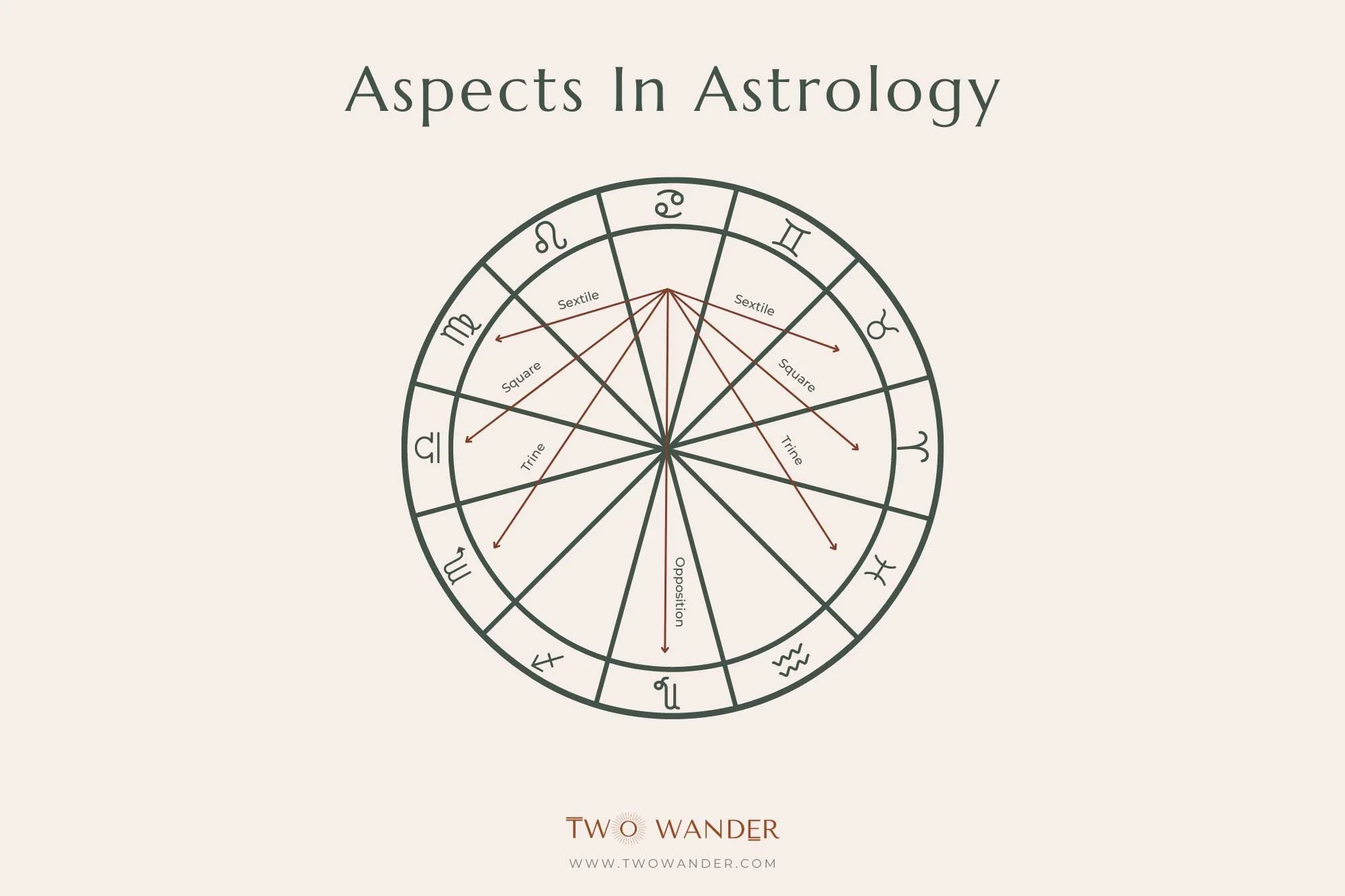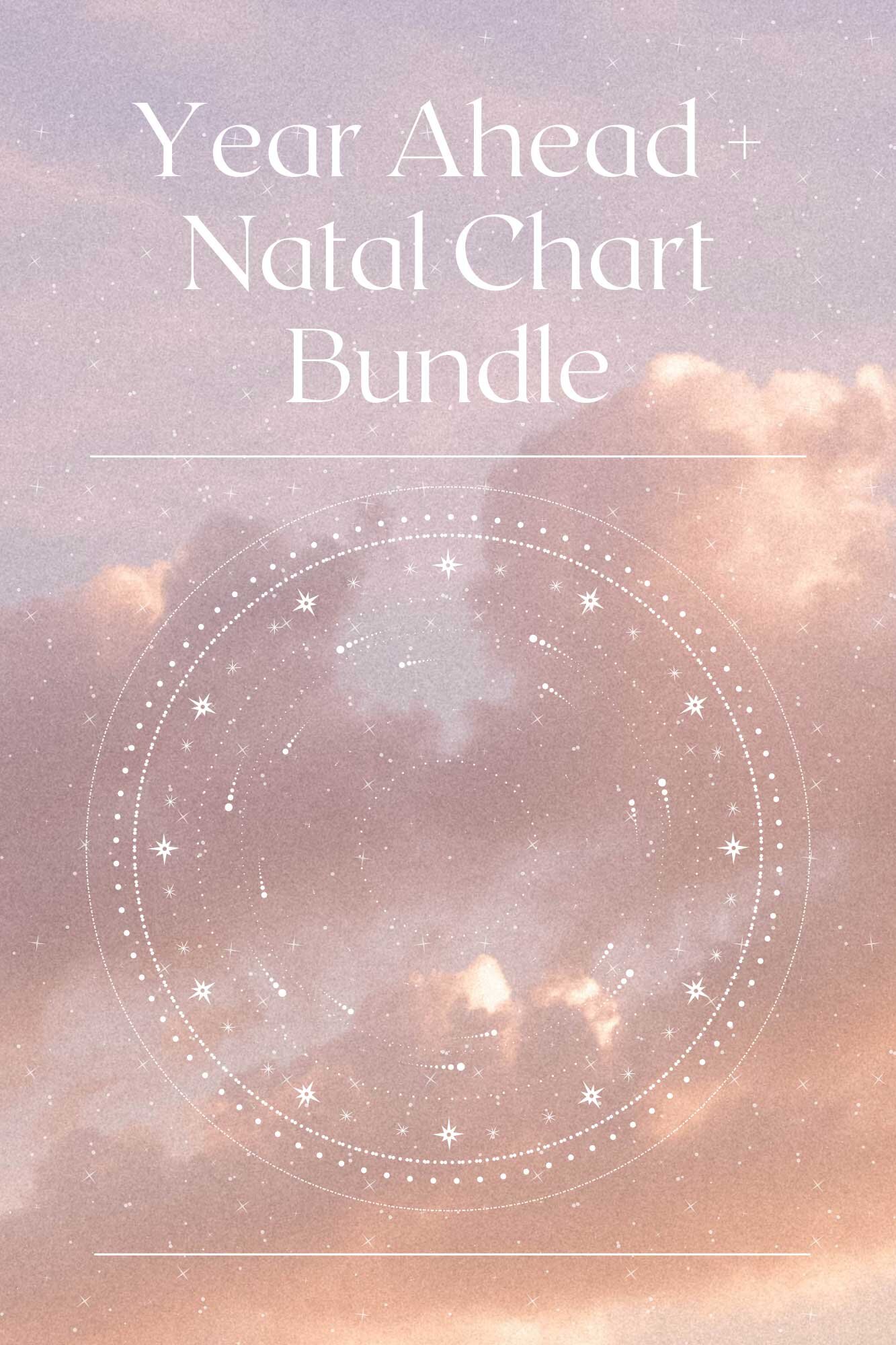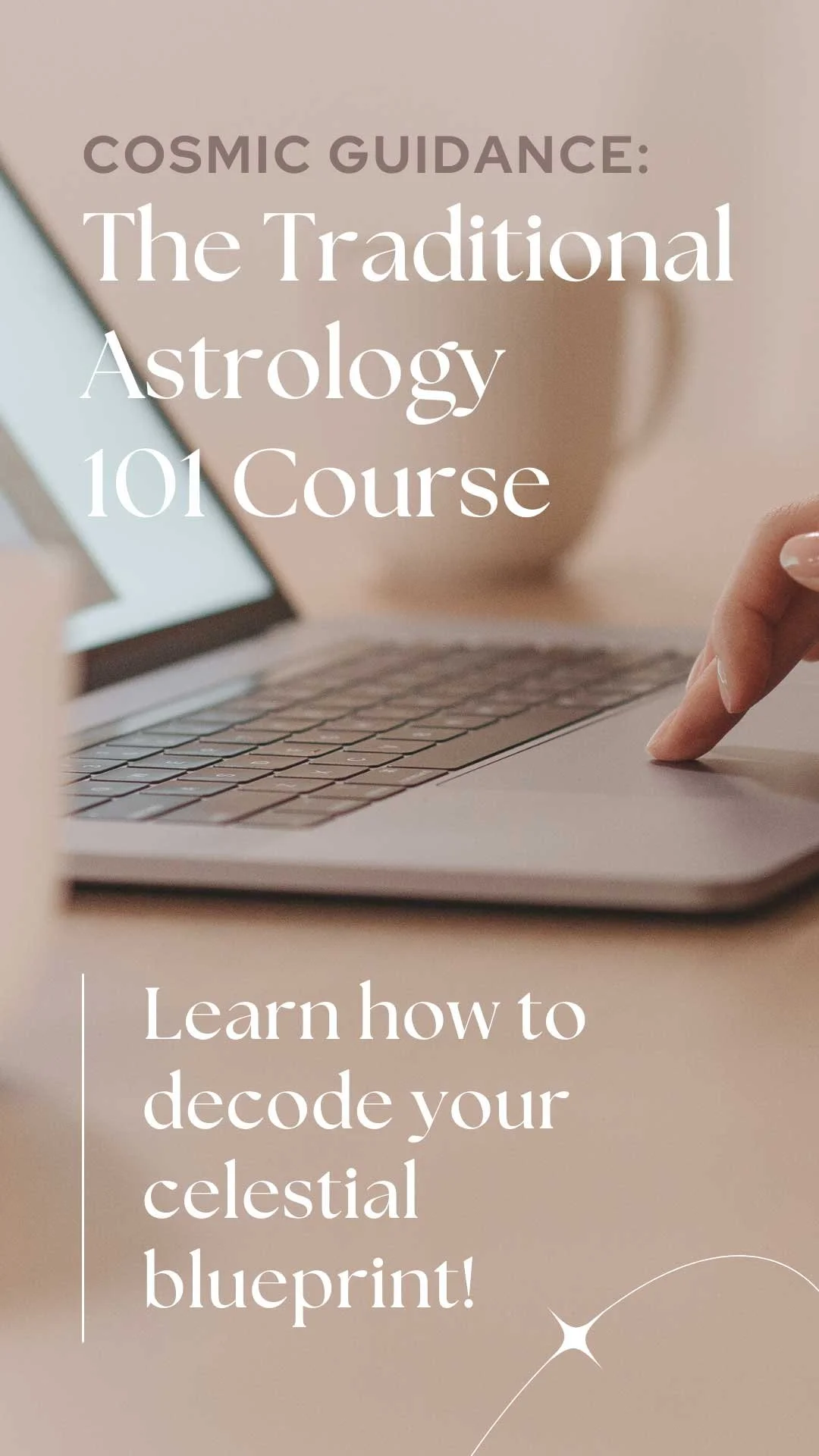Interpreting The Planet Aspects In Astrology
This post might contain affiliate links. If you choose to purchase through these links, we may receive a small commission at no extra cost to you. By using these links you are directly supporting our ability to share our mystical musings, thank you!
Interpreting The Planet Aspects In Astrology
Interpreting the Planet aspects in Astrology is a fundamental process in the analysis of a Natal Chart and for forecasting in mundane Astrology (such as with our free weekly and monthly horoscope), as well as in predictive timing techniques such as charting the current transits against the birth chart, used in Solar Return + Year Ahead readings, electional, and horary Astrology.
The aspects basically describe the relationship of the Planets between each other in the sky from our vantage point on Earth. When we look at a chart of the sky, we are mapping a 3D reality onto a 2D plane in order to interpret it, in this 360º wheel, the “distance” from each other and the angles they form between their points, are the aspects.
As a visual representation it is much simpler to contextualise, read on for further details:
Astrological Planetary Aspects
The Astrological aspects represent the distance and angle between two or more Planets or points in the Natal Chart. It measures their respective degrees apart on an Astrology chart for layers of interpretative nuance. Like a dance or conversation, when the Planets are interacting with each other in this way, they influence each other.
Each Zodiac Sign can be seen as an archetype, the Planet that is in that Zodiac Sign enacts its properties (such as action or ambition for Mars), in the style of that Zodiac Sign. The House it occurs in, shows the area of life in which this takes place, and the aspect is the tone.
As a very basic example, Mercury is the Planet of the mind and communication, in Aries it is a fast-thinking, bold speaker. If it is in the 1st House of Self (where it is also in its “joy”), it can mean that self-expression is a fundamental part of this person’s identity, they may love to talk and be strongly tied to their thoughts, opinions, and mind. Their identity is fused with their ideals, and they will be known as a strong communicator.
If Mercury is also opposing Saturn, the Planet of restraint, however, this can significantly temper any usual Aries brashness and make them more reserved sharers with a potential for worrying what others think, what is the “right” thing to say, or fear judgement of others.
It can also make them more pessimistic or prone to a sense of defeat in relation to other Aries Risings (however, Saturn is exalted in Libra, which is the Sign opposite) and so there is also the potential for this to be harnessed for a mature and compromising mindset, especially if a Night Chart).
As with all placements in the Chart, it is absolutely essential that the whole Chart be taken into context in the analysis. Rarely does anything operate in isolation (very occasionally you can get unaspected Planets however that operate in “purer” expressions of the Zodiacal and Planetary archetype).
Overall, the aspects bring a flavour and a nuance to the interpretation of every Planet in relation to each other, their energy influences the other when they are in some kind of contact (which is in turn nuanced based on the Zodiac Sign and House it is in).
There are 5 “major” or Ptolemeic aspects, with two so-called easy and two so-called hard aspects, with one that can go either way depending on the Planets involved:
The Five Major Aspects
Conjunction:
This is when two or more Planets are very close to each other in the Chart, usually within a 5º orb of influence is considered for most Planets and up to 10º for the luminaries (Sun and Moon). I usually consider aspects with 5º or less as strong, and for the luminaries around 7º but will take into consideration up to 8-10º depending on the Planet involved and the influence on the rest of the chart.
The aspects are based on the concept of whether the Planets can “see” each other or not, whether they are said to be able to cast rays on the other. Technically a conjunction is not an aspect but an absence of aspect, as they up to 0º degrees apart. However for ease, it is usually simply called an aspect.
Traditionally for Planets to be considered conjunct, they need to be in the same Zodiac Sign, but some consider out-of-Sign conjunctions if they involve personal Planets (Sun, Moon, Mercury, Venus, Mars) with one Planet close to another Planet in the next Sign.
The closer the exact conjunction (the smaller the orb of influence), the stronger the energy. For example, a Planet at 15º Taurus and another at 16º Taurus are considered tightly (partile) conjunct. If another Planet were at 21º Taurus, this would be a looser conjunction.
When Planets are conjunct their energy can be considered to be fused and blended together. It is like a union and concentration of energy. Whether this is more constructive or challenging depends on the Planets in question.
For example, a Sun-Saturn conjunction can dim the light of the Sun, adding caution and seriousness. A Mars-Sun conjunction adds a fieriness and tempestuousness to the identity. A Mercury-Moon conjunction brings a strong capacity and emotional need for self expression, and puts heart and mind on the same page, etc.
-> Planets that are less than 15º degrees away from the Sun are also said to be “under the beams” of its rays, which can cause a type of eclipsing effect on their energy, being blinded by its light. This also ties it more strongly into the identity of the native but can make it harder to distinguish on its own.
It intensifies the closer the orb of influence gets, for conjunctions less than 8º from the Sun it is considered “combust”, and for extremely tight (and rarer) conjunctions of just 17 arc minutes apart (basically less than 1º) it is called a “cazimi”, or in the heart of the Sun. This offers it a sense of protection.
If 3-4 Planets or more are in the same Sign, they also form a so-called stellium, whether or not they are all conjunct, which brings a significant influence and focus to this Sign and House in the Natal Chart of the person (or general felt energy of the collective for current mundane transits).
2. Sextile:
A sextile aspect is when two or more Planets are 60º, or 2 Signs apart. This is a harmonious aspect that brings ease and flow between the Planets. They are in Signs of the same duality, i.e. nocturnal or diurnal, and so understand each other on a basic level.
These are Fire with Air Signs (diurnal), and Water with Earth Signs (nocturnal). Sometimes, especially in mundane Astrology tracking the current transits of the Planets for forecasting, it can be considered a “weak” aspect in the sense that effort or action is needed in order to harness these positive qualities. The potential is there, but we must also be engaged with them. It can be seen as the nature of Venus, the “lesser” benefic.
For example, someone with a Moon-Neptune sextile may have the potential to be highly creative, artistic, intuitive, and empathetic, but they will also need to actively be aware of and engage with these characteristics. In general though, the energy does flow smoothly between the Planets, they may just not be felt as strongly as another aspect.
3. Square:
This is a challenging aspects in which two or more Planets are 90º, or 3 Signs, apart. This is literally like a square-off, the Signs the Planets are in do not understand each other and are having a hard time seeing eye-to-eye. A square aspect generally brings friction or tension, but it can also act as a motivating force. They are not only not of the same duality, but they are also of the same mode/quality, meaning they are actually similar in some ways so they butt heads. It can be seen as the activating and conflicting energy of Mars, the lesser malefic.
The modes/qualities denote whether a Sign falls at the beginning, middle, or end of a season. The Cardinal Signs kick off the seasons and are seen as the leaders and initiators, these are Aries (Spring), Cancer (Summer), Libra (Autumn), and Capricorn (Winter), this dynamic can result in power struggles or differences in authority.
The Fixed Signs come in the middle of the seasons and so are seen as stable and persevering, they are Taurus (Spring), Leo (Summer), Scorpio (Autumn), and Aquarius (Winter), being set in their ways, stubbornness can be an issue between these Signs.
The Mutable Signs come at the end of the seasons and bring about change and flexibility, they are Gemini (Spring), Virgo (Summer), Sagittarius (Autumn), Pisces (Winter), between these there can be a mismatch in the way things are handled or dealt with.
As an example, a Mercury-Uranus square (with Mercury in Scorpio and Uranus in Aquarius say) can bring an electric or destabilising sense to the mind, it may be difficult to concentrate on one thing for long periods of time, or anxiety may be an issue. On the other hand, it can also bring a unique perspective and alternative, visionary, and quirky way of communicating (if harnessed in tandem with grounding techniques).
4. Trine:
This is a positive, harmonious aspect in which there is easy flow and the Planets involved are in Signs that can see and understand each other. The energy is similar to the sextile but stronger, it is supportive and can be leveraged as an asset. Planets trining each other are 4 Signs, or 120º, apart in the Chart. It means they are in Signs of the same element (Fire, Earth, Air, Water), and so have a fundamentally similar and cooperative way of behaving. It can be seen as the energy of Jupiter, the greater benefic.
This collaboration can bring a natural talent or strength in a Chart, such as a Mars in Capricorn and a Mercury in Virgo trine can lead to strong mental analysis and ability to act on plans. A Venus in Pisces trining Neptune in Cancer can bring strong healing capacities for others, for example.
Aspects are also fundamental in synastry, where two charts are mapped over each other. If the respective Moons are in Signs of the same element, such as a Water Moon trine in Cancer and Pisces), they will understand each other on an emotional level.
5. Opposition:
This is another challenging aspect in which Planets are facing off. Sometimes it can feel like being pulled in two different directions, like a see-saw, and there is a need to find a compromise and harmonise the two sides. It is when Planets are in a polarity, opposing Houses, 6 Signs or 180º apart. In this dynamic, there can be an invitation to reconcile what is like two-sides of the same coin.
All of the Signs and Houses are in a duality, Aries and Libra is self vs other, likewise with the 1st and 7th House. Both are needed, it is about striking a balance. Like a square, this is a hard aspect that can feel conflicting and bring tension but in a more contrasting way. Through this stress, like in opposites attracting, slow and constant action can bring about reconciliation. It is seen as the energy of Saturn, the greater malefic.
For example, a Sun-Jupiter opposition can bring a larger-than-life character or grandiosity in identity, while this will generally be good natured and humoured, there can also be a need to not aggrandise the sense of self and find a balance between joviality and temperance.
In general, the trine and the sextile are the most harmonious, the trine more strongly so. The square and the opposition bring about friction and tension, through which there is always the opportunity for growth and drive (if everything were easy we wouldn’t do much with it- sometimes, like a Grand Trine in which there is a trine between 3 or more Planets in all the Signs of the same element- we can become complacent when we are too naturally talented, blessed, or gifted, there is no grit or determination to strive for)!
Beyond these 5 major aspects, there are also 4 “minor” or non-Ptolemaic aspects, which some modern Astrologers employ. The minor aspects are the quintile 72º apart, sesquisquare 135º apart, quincunx or inconjunct 150º, and the biquintile 144º. On top of these, there are also another 9 less commonly used minor aspects.
Then there are the rarer aspect patterns that, when aspects are combined together, can form special configurations such as the Yod, the Grand Trine discussed above, the Cradle, Rectangle, Kite, or Castle.
Of these extra aspect patterns, I only personally only use the t-square which is an aspect pattern composed of a Planet squaring two others, both of which are also opposing each other (forming what looks like a geometry t-square ruler, or a right-angle triangle). This is often a focal point or defining feature in a native’s life. The “apex”, Planet that is squaring both other Planets is the key point of tension and attention. Release can be found in the point opposite the apex, as if it were a drawn bow and arrow where it would shoot to.
For example, if the Moon in Aquarius in the 3rd House is squaring the Sun in Taurus in the 6th House and Uranus in Scorpio in the 12th House, with the Sun and Uranus also opposing each other, it can feel like a constant tug-of-war between trying to find a focus or an outlet for healthy emotional self-expression, being over-identified with work, being of service, and the need for stability and routine, and a desire to break free and experience frequent change in life and diversity in inner wellness needs.
Release can be found in exploring the Leo 9th House: having fun and playing with spirituality and personal philosophy, and experiencing the world.
So that’s how to interpret the Astrology Planetary aspects. It is an essential component in deciphering a Natal Chart or creating a forecast, one in which there are many different interpretations available! Let me know if you have any questions or anything to add about them in the comments section below.
If you would like me to personally interpret your Natal Chart for you, I’d be honoured to be of service- you can book in a Soul Reading with me here :)
If you would like to self-study, get our Beginner’s Astrology + Natal Chart Guidebook! or our Cosmic Guidance: Astrology 101 Course.


























